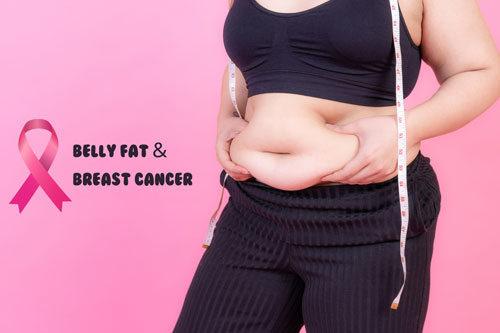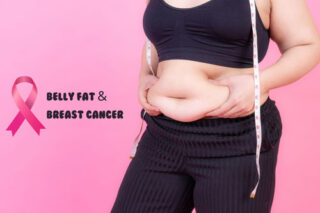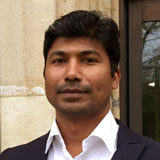Shocking! High Belly Fat May Triple Your Breast Cancer Risk. Act Now or Risk Everything!

Shocking! High Belly Fat May Triple Your Breast Cancer Risk. Act Now or Risk Everything!
Dr. Suman Kumar Ankathi
India’s Leading Breast Imaging Expert
 Belly fat vs. Obesity: What’s the difference? Who’s worse?
Belly fat vs. Obesity: What’s the difference? Who’s worse?
Many believe that only overall body weight (BMI) matters, but research[1] shows that where you store fat matters much more.
- A High BMI means being overweight or obese overall, but it doesn’t always mean higher breast cancer risk.
- A High waist-to-hip ratio (WHR) due to excess belly fat is a major red flag, even if you are otherwise thin. Women with a WHR equal to or more than 0.95 face up to 330% higher breast cancer risk, regardless of their BMI.
- For example, if your waist is 32 inches and your hip circumference is 33 inches, your waist-to-hip ratio (WHR) is 32/33 = 0.97.
- This risk applies before and after your menopause. In fact, premenopausal Indian women with high WHR are at higher risk.
- If your BMI & WHR are both high, your breast cancer risk is even higher.
Hence, it’s crucial for you to take action now.
Why are Indian women at higher risk? The ‘Thin-Fat’ problem
South Asians, including Indian women, often appear slim but store more fat around the belly. This ‘thin-fat’ body type[2] makes them metabolically prone to many diseases, including breast cancer, even if their BMI or weight is normal. That means you could be at higher risk without realising it!
The best defense? Lifestyle changes & routine mammograms
1. Lifestyle changes that cut your breast cancer risk
- Exercise: Just 30 minutes of brisk walking daily can lower your risk.
- Diet: Reduce sugar and processed foods and increase fibre from fruits, vegetables, and whole grains.
- Maintain a Healthy Waistline: Keep your WHR below 0.85 to stay in the safe zone.
2. Routine annual mammograms: A lifesaving habit.
- No one can prevent breast cancer, but breast cancer caught early (stage 1) is 99% curable.[3] On the contrary, late detection drastically reduces survival chances. So, don’t wait for symptoms—get screened annually!
- While the self-exams are popular, they’re not enough to keep you safe. Relying solely on self-exams could mean missing the early, treatable signs of breast cancer.
- Mammography, mainly 3D mammography, is the most reliable way to detect breast cancer early – before it can be felt with hands. Unlike conventional 2D mammograms, which take flat images of your breast tissue, 3D mammography takes multiple pictures from different angles, providing a more detailed view. This enables radiologists to identify subtle, early changes that a self-exam or 2D mammogram may miss.
- 3D mammography is far superior to 2D scans, especially in women with dense breasts (common among Indians).
Why 3D mammography is a game changer
Here’s how the latest 3D mammography outshines the earlier versions to keep you safer:
- Enhanced clarity: It provides detailed, three-dimensional images, making it easier to detect small tumors by using innovative technology designed to produce clear images of the breast tissue, layer by layer.[4]
- Reduced recalls: 3D mammography exams help considerably reduce recall rates for additional tests.[5]
- Better detection: 3D mammography exams enable the detection of more cancer cells[6], and 20–65% more invasive breast cancers than 2D alone, with an average increase of 41%.[7]
- Helps high-risk women more: 3D mammography is beneficial in high-risk women, i.e., including those with:
- Changes or lumps in the breasts
- A family history of breast or ovarian cancer[8]
- Dense breast tissue (nearly half of all women above the age of 40 have dense breasts)[9]
- A previous diagnosis of breast disease
This means two simple things: Earlier detection than ever before and less anxiety about unnecessary further testing.[10]
Routine mammograms often yield reassuring news that ‘all is well.’
Busting myths about breast cancer screening
Despite overwhelming evidence of the benefits of mammograms, many popular myths may discourage you from undergoing routine screening. Let’s bust a few of them one by one.
- Myth: “I feel fine, so I don’t need a mammogram.”
Fact: Early breast cancer has NO symptoms. - Myth: “No family history means I’m safe.”
Fact: 80% of cases occur in women with NO family history. - Myth: “Mammograms are painful and harmful.”
Fact: They are quick, safe, and life-saving. - Myth: “Only older women get breast cancer.”
Fact: Indian women are getting diagnosed younger—don’t ignore it! - Myth: “A healthy lifestyle alone prevents cancer.”
Fact: Diet and exercise help, but screening is key.
In Conclusion:
Understanding the dreadful consequences of late breast cancer diagnosis can empower you to stay breast-healthy. Here are some general tips for your action:
- Never miss your healthy diet, daily exercise, and annual mammogram: Both your healthy lifestyle and yearly mammograms are vital. Mammograms can detect breast cancer early when it is most treatable. Don’t rely on breast self-exams or other modalities. Make it a priority to schedule your yearly screening even if you feel perfectly healthy.
- Select the right mammography center: You may have several options available to you for getting a mammogram, such as a diagnostic lab, a hospital, or a dedicated breast clinic. How do you choose one among all the available options? Here are three easy steps to help you choose the right mammography center.
- Overcome your mammography anxiety if you have any: If you feel anxious before a mammography session, you are not alone. Your stress could be due to either it being your first mammogram, your fear of discovering cancer, myths harboured in your mind, or your past uncomfortable experience. Whatever your reason, it’s important to remember that mammograms save lives, and here are seven tips to help you relax before your next mammogram.
- Stay informed. Stay healthy: Your family needs you forever. Your health is as important to them as it is to you. Keep up with the latest research and reliable information on mammography and breast health. Follow healthy routines and medical advice to protect yourself and your loved ones.
- Get your mammogram today: Early detection protects best against breast cancer. 3D mammography gives you the best chance of catching breast cancer early when it’s most treatable. So, don’t wait or rely solely on self-exams. If you are eligible for breast screening either by age (40 years and above) or due to high-risk factors such as family history (in which case even if you are younger than 40 years), subscribe today to an annual screening mammography plan at a center near you and never miss your test—a simple ritual that can save your life!
It’s not just about you – it’s about being there for your loved ones.
Take charge of your health and encourage other women to do the same.

Dr. Suman Kumar Ankathi
DNB (Radiodiagnosis), Fellowship in cancer imaging, TMH
Master in Research (Mres) King’s College, London.
Ex Professor, Tata Memorial Centre, Mumbai
Currently working as Consultant Radiologist at
The Breast Clinic, Unit of Holistic Oncocare Centre, Mumbai
- Nagrani R, Mhatre S, Rajaraman P, et al. Central obesity increases risk of breast cancer irrespective of menopausal and hormonal receptor status in women of South Asian Ethnicity. European Journal of Cancer. 2016;66:153-161. doi: https://doi.org/10.1016/j.ejca.2016.07.022
- Venkataraman H, Ram U, Craik S, Arungunasekaran A, Seshadri S, Saravanan P. Increased fetal adiposity prior to diagnosis of gestational diabetes in South Asians: more evidence for the “thin–fat” baby. Diabetologia. 2017;60(3):399-405. doi:https://doi.org/10.1007/s00125-016-4166-2
- Giaquinto AN, Sung H, Miller KD, et al. Breast Cancer Statistics, 2022. CA: A Cancer Journal for Clinicians. 2022;72(6). doi: https://doi.org/10.3322/caac.21754
- Friedewald SM, Rafferty EA, Rose SL, Durand MA, Plecha DM, Greenberg JS, Hayes MK, Copit DS, Carlson KL, Cink TM, Barke LD, Greer LN, Miller DP, Conant EF. Breast cancer screening using tomosynthesis in combination with digital mammography. JAMA. 2014 Jun 25;311(24):2499-507. doi: 10.1001/jama.2014.6095. PMID: 25058084. https://pubmed.ncbi.nlm.nih.gov/25058084/
- Rose SL, Tidwell AL, Bujnoch LJ, Kushwaha AC, Nordmann AS, Sexton R Jr. Implementation of breast tomosynthesis in a routine screening practice: an observational study. AJR Am J Roentgenol. 2013 Jun;200(6):1401-8. doi: 10.2214/AJR.12.9672. PMID: 23701081. https://pubmed.ncbi.nlm.nih.gov/23701081/
- Skaane, Per, et al. “Comparison of digital mammography alone and digital mammography plus tomosynthesis in a population-based screening program.” Radiology 267.1 (2013): 47-56. https://pubs.rsna.org/doi/full/10.1148/radiol.12121373
- Friedewald SM, Rafferty EA, Rose SL, Durand MA, Plecha DM, Greenberg JS, Hayes MK, Copit DS, Carlson KL, Cink TM, Barke LD, Greer LN, Miller DP, Conant EF. Breast cancer screening using tomosynthesis in combination with digital mammography. JAMA. 2014 Jun 25;311(24):2499-507. doi: 10.1001/jama.2014.6095. PMID: 25058084. https://pubmed.ncbi.nlm.nih.gov/25058084/
- https://www.canceraustralia.gov.au/sites/default/files/publications/breast-cancer-risk-factors-review-evidence/pdf/rfrw-breast-cancer-risk-factors-a-review-of-the-evidence_1.15.pdf accessed 30 Nov 2024
- https://www.cancer.gov/types/breast/breast-changes/dense-breasts accessed 30 Nov 2024
- Zuley ML, Bandos AI, Ganott MA, Sumkin JH, Kelly AE, Catullo VJ, Rathfon GY, Lu AH, Gur D. Digital breast tomosynthesis versus supplemental diagnostic mammographic views for evaluation of noncalcified breast lesions. Radiology. 2013 Jan;266(1):89-95. doi: 10.1148/radiol.12120552. Epub 2012 Nov 9. PMID: 23143023; PMCID: PMC3528971. https://pubmed.ncbi.nlm.nih.gov/23143023/
